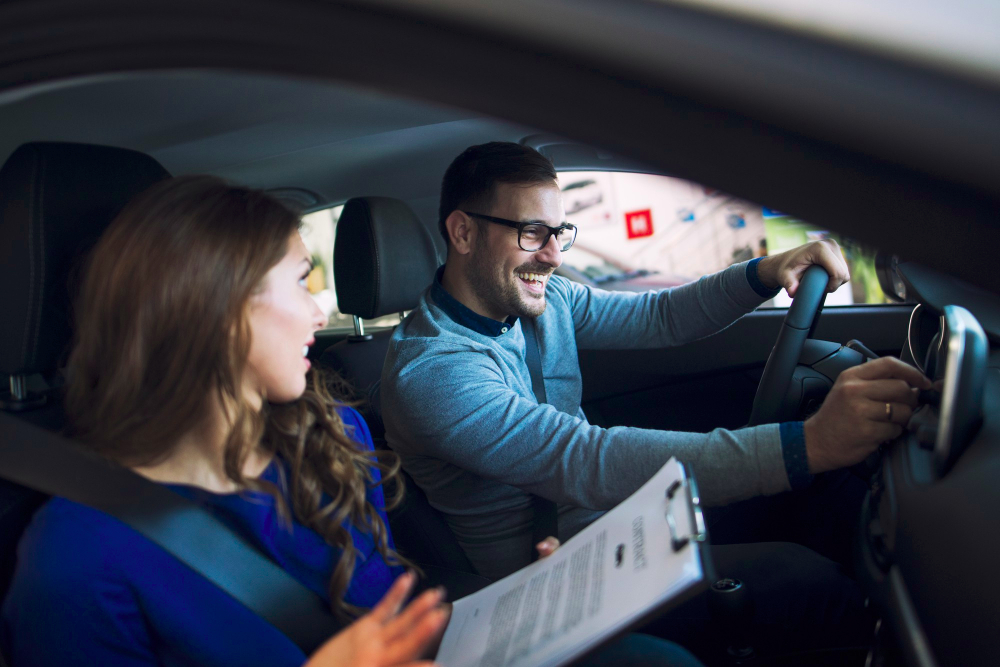
Learner drivers face a variety of challenges as they prepare for their practical driving test. From mastering clutch control to executing complex maneuvers like parallel parking, the test assesses a wide range of driving skills.
Parallel parking is one of the three potential maneuvers that may be required during your test. If you’re still working on perfecting this skill, RD2SuccessFastTrack’s comprehensive guide to parallel parking can provide valuable assistance.
This guide will delve into the intricacies of parallel parking, including safe execution techniques, key points to consider for the examiner, and real-world applications of this maneuver.
What is parallel parking?
One of the three potential maneuvers assessed during the driving test, the parallel parking maneuver involves parking your vehicle parallel to the road, typically in a designated parking space. During the test, you’ll usually be asked to drive alongside a parked vehicle and then reverse into the space behind it.
While parallel parking can be challenging, consistent practice can significantly improve your skills. There’s a one-in-three chance that you’ll be required to perform this maneuver during your test. If selected, the examiner might provide instructions like this:
“Please stop before reaching the next parked car. You will now perform the parallel parking maneuver. Drive forward and stop alongside the car ahead. Then, reverse into the space behind the vehicle and park parallel to the curb, keeping it within two car lengths.”
What is the examiner looking for?

The examiner will closely monitor the candidate’s performance throughout the parallel parking maneuver, assessing the following key areas:
- Vehicle Control: The candidate’s ability to control the vehicle, including clutch and steering input, and maintain a safe speed.
- Mirror and Blind Spot Checks: The frequency and accuracy of mirror and blind spot checks to ensure awareness of surroundings.
- Steering Precision: The precision of steering inputs, particularly during the turning point and straightening of the vehicle.
As the candidate executes the maneuver, they should prioritize the following:
- Coordination: Combining accurate steering and reversing with constant observation to maintain situational awareness.
- Precision: Ensuring precise steering to park within a reasonable distance from the curb, avoiding contact.
- Control: Maintaining a controlled speed to prevent errors and maintain safety.
Important Considerations:
- Safety First: Always prioritize safety and be mindful of other road users.
- Spot Selection: Choose parking spaces that are suitable for your vehicle’s size and your driving ability.
- Practice Makes Perfect: Consistent practice is key to mastering the parallel parking maneuver.
By focusing on these aspects and practicing regularly, you can improve your parallel parking skills and increase your chances of success during the driving test.
Step-by-step: How do I parallel park?
1. Pull alongside the car
The examiner will begin by instructing you to park on the left side of the road, well before the nearest parked vehicle. Once positioned, they will provide further instructions and observe as you maneuver your vehicle alongside the parked car in preparation for the parallel parking maneuver.
Before reversing, it’s crucial to conduct a thorough check of your mirrors and blind spots to ensure there are no obstructions. If there’s heavy oncoming traffic, patiently wait for a clear opportunity to avoid causing delays or unnecessary stress.
When the road is clear, gently engage the reverse gear and start moving the car backward at a slow and controlled pace. Continuously monitor your mirrors for approaching vehicles, cyclists, or pedestrians. If necessary, signal your intentions with the left indicator.
Aim to stop your car slightly ahead of the parked vehicle, maintaining a safe distance of approximately half a meter to a meter. This will provide adequate space to complete the maneuver without risk of collision.
Once you’ve stopped, cancel the indicator and engage reverse gear. The reverse lights will signal your intentions to other road users.
Now, carefully steer the wheel to the right, guiding the rear of your car towards the curb. As you reverse, keep an eye on your mirrors to ensure you’re staying within the lines and avoiding any obstacles.
When you’re close to the curb, gently turn the steering wheel to the left to straighten the car. Be mindful of the distance between your car and the curb; aim for a safe distance without getting too close.
Finally, once you’ve parked parallel to the curb, check your mirrors one last time to ensure there are no obstructions before engaging first gear and moving forward slightly. This will help to straighten your car and ensure it’s parked neatly within the lines.
2. MSM and correct positioning
Once you’ve positioned your vehicle correctly, prepare to execute the reverse parking maneuver. Before initiating the maneuver, conduct a thorough visual check of your surroundings using mirrors and blind spot checks. If any obstructions, such as oncoming vehicles, cyclists, or pedestrians, are present, wait for them to clear the area before proceeding.
As you begin reversing, maintain a slow and controlled speed. Keep your eyes focused on the rearview mirror to monitor your progress. Use the steering wheel to make small, precise adjustments, ensuring your vehicle remains on a straight path.
Aim to align the rear of your vehicle with the rear of the car in front. You can use reference points, such as aligning the side mirrors, to assist in gauging the correct distance. However, it’s generally safer to position your vehicle slightly further back than too close, to avoid any potential collisions.
Throughout the maneuver, consistently check your mirrors and blind spots to ensure the safety of other road users. Once you’ve achieved the desired position, bring your vehicle to a safe stop. Remember, patience and precision are key to successfully executing the parallel parking maneuver.
3. Find your reference point and reverse into the spot
Executing the Parallel Parking Maneuver
Once your vehicle is positioned correctly, initiate the reversing maneuver. Prior to doing so, conduct a thorough Mirror, Signal, Maneuver (MSM) check to ensure safety.
As you begin reversing, the front of your vehicle will naturally swing outwards. This is known as the point of turn. To mitigate the risk of obstructing oncoming traffic or pedestrians, carefully check your mirrors and blind spots before proceeding.
Reverse slowly, gently turning the steering wheel to the left. A slight turn is usually sufficient to guide your vehicle into the parking space. Maintain constant observation through your rearview mirror.
As you approach your reference point, typically when the left corner of your vehicle aligns with the right corner of the adjacent vehicle (consult your instructor for specific guidance), remain vigilant for any potential hazards. If necessary, pause the maneuver to allow oncoming traffic or pedestrians to pass.
Breaking down the parallel parking maneuver into smaller steps can simplify the process and enhance your ability to make necessary adjustments. Pausing at the reference point allows you to assess the situation and make any required corrections.
4. Full lock and straighten up
As you near the completion of the parallel park maneuver, it’s crucial to maintain focus and precision. Once you’ve aligned your vehicle parallel to the curb, you’ll need to straighten the steering wheel and apply the handbrake to secure your position.
If you’ve left a significant gap between your vehicle and the one in front, carefully move forward to reduce the distance. However, ensure that there’s still sufficient space to maneuver when you’re ready to leave the parking spot.
Breaking down the parallel park into smaller, more manageable steps can significantly alleviate anxiety and improve your performance. By focusing on each step individually, you can approach the maneuver with confidence and precision.
Remember, practice is key. The more you practice parallel parking, the more comfortable and proficient you’ll become.
When would this be used in real life?

Parallel parking is a fundamental driving skill that is frequently encountered in various driving scenarios. Whether you reside in a residential area with limited parking spaces or navigate the congested streets of a city center, the ability to parallel park effectively is essential.
While it may not be a daily necessity, parallel parking can be a valuable skill in situations where finding suitable parking spaces is challenging. Remember to always check for parking restrictions and ensure that the chosen parking space is appropriate for your vehicle.
FAQs
1. What are the chances I’ll be asked to complete this manoeuvre?
Remember, there’s a one-in-three chance that you’ll be asked to perform the parallel parking maneuver during your driving test. Don’t neglect practicing this essential skill, as mastering all three potential maneuvers will increase your confidence and maximize your chances of success.
2. What other manoeuvres are there?
In addition to parallel parking, the driving test may assess two other maneuvers:
- Bay Parking: This can be either reversing into a parking bay and driving out, or driving into a bay and reversing out.
- Pulling Up on the Right: This involves pulling up to the right-hand side of the road and stopping safely.
3. Can I refuse to complete the parallel park?
If you’re asked to perform the parallel parking maneuver during your driving test, it’s crucial to comply with the examiner’s instructions. Refusal to complete this maneuver will result in the immediate termination of the test.
If you have any doubts or uncertainties about the instructions, don’t hesitate to ask the examiner for clarification. Clear communication is essential to ensure a smooth and successful test experience.
4.Where will I be asked to perform this maneuver?
The examiner has the discretion to select the location for the parallel parking maneuver. While they may choose a quieter residential area, it’s important to be prepared for the possibility of performing the maneuver on a busier road. Examiners prioritize safety and efficiency, so they’re unlikely to choose a location that would cause significant traffic disruption.
5. When in the test will I be asked to demonstrate this manoeuvre?
The examiner will determine the specific timing for the parallel parking maneuver. It’s important to remain calm and focused throughout the test, and to execute the maneuver when instructed. Avoid worrying about when it might occur, as this can distract you from your driving. Instead, concentrate on your driving skills and be prepared to perform the maneuver confidently when the time comes.
6. What should I do if I think I’m about to hit the kerb?
Remember, there’s no need to rush through the parallel parking maneuver. Take your time and use your mirrors to accurately gauge your distance from the curb. If you find yourself too close, simply drive forward, reposition your vehicle, and try again.
7. Will the examiner get out to check how far I am from the kerb?
Given the extensive experience of driving examiners, they are adept at assessing a learner driver’s ability without needing to physically exit the vehicle. By observing your mirror usage and overall driving performance, they can accurately gauge your competence.
8. Will I fail if I hit the kerb?
The outcome of hitting the curb during a driving test depends on the severity of the incident. A minor touch may go unnoticed or be overlooked by the examiner. However, if the vehicle mounts the curb, it will likely result in an automatic failure. By taking your time, using your mirrors effectively, and practicing regularly, you can significantly reduce the risk of such errors.
9. How long is two car lengths?
The examiner will typically ask you to park within two car lengths of the vehicle in front. Standard parking spaces are approximately 4.8 meters long, so two car lengths would be around 9.6 meters. While exact precision isn’t necessary, you should aim to park within a reasonable distance.
10. What if there’s a lot traffic when I’m trying to complete this manoeuvre?
If you encounter significant oncoming traffic, you may proceed with the parallel parking maneuver, provided the examiner doesn’t specify otherwise. Remember to signal your intentions to other road users and proceed cautiously. Avoid rushing the maneuver; instead, take your time to ensure a safe and accurate execution.
11. Is there a time limit in place for completing this manoeuvre?
While there isn’t a strict time limit for the parallel parking maneuver, it’s generally expected to be completed within a reasonable timeframe. Excessive hesitation or multiple adjustments may prompt the examiner to encourage you to proceed more efficiently.
12. Will I fail if I can’t complete the manoeuvre?
While maneuvers can be daunting for many learners, it’s important to approach them with confidence. Remember, it’s normal to make minor mistakes during the driving test. However, significant errors, such as hitting the curb or refusing to complete a maneuver, will likely result in a failed test
14. Will the examiner check how far I am from the car in front?
The examiner won’t use a measuring tape to assess the distance between your vehicle and the one in front. They can easily determine if you’re too far or too close. If necessary, they may provide guidance to adjust your position.



